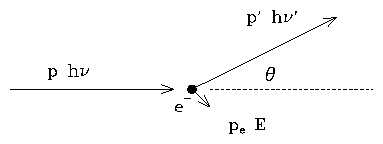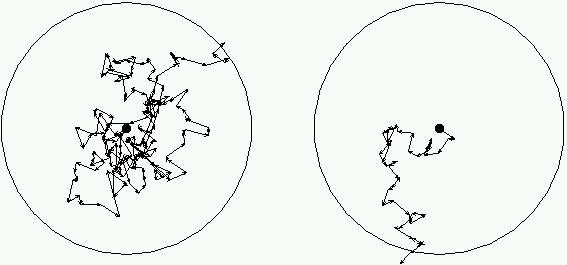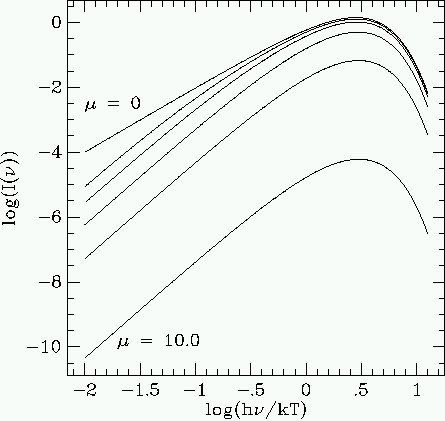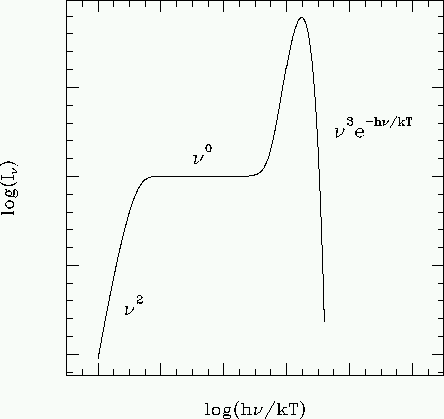
Thomson scattering, or the scattering of a photon by an electron at rest, strictly only applies at low photon energy, i.e. when hn << me c2.
If the photon energy is comparable to or greater than the electron energy, non-classical effects must be taken into account, and the process is called Compton scattering. A further interesting situation develops when the electron is moving - in this case energy can be transferred to the photon, and the process is called inverse Compton scattering. This last process is an important mechanism in high energy astrophysics.
In Thomson scattering, we have
| (1) |
where sT is the Thomson cross-section, W the solid angle, q is the angle of scattering, and r0 is the classical electron radius,
| (2) |
In Thomson scattering the incident photon and scatter photon have the same wavelength or energy, so this scattering is also called coherent or elastic.
If we now move to photons of energy hn\ga me c2, the scattering is modified by the appearence of quantum effects, through a change in the kinematics of the collision, and an alteration of the cross-section.
To do the kinematics of the collision correctly at high photon energy, momentum and energy must be conserved.
Let the incident photon have energy hn and momentum hn/c, the scattered photon have energy hn¢ and momentum hn¢/c, and the electron (initially at rest) acquires energy E and momentum pe. The scattering angle is q.
|
Problem 7.1 Show that the energy of the scattered photon is given by
|

In terms of wavelength, this reduces to
| (4) |
where l is the incident photon wavelength, l¢ is the scattered photon wavelength and lC is the Compton wavelength and is given by
| (5) |
|
Problem 7.2 Prove Eqn 7.4.
|
The compton wavelength can be regarded as a wavelength change Dl in the incident photon. Note that for l >> lC the change is negligible and we get back the Thomson scattering.
In full treatment of the problem yields the Klein-Nishina formula for the scattering cross-section:
| (6) |
which can be shown to yield the following formulae for the total cross-section (where x = [(hn)/(mc2)]),
| (7) |
and
| (8) |
for the non-relativistic and extremely relativistic cases. The main effect is thus to reduce the cross-section at high photon energies, i.e. the scattering of the photons becomes less efficient.
An important case arises when the electrons are no longer considered to be at rest. In inverse scattering, energy is transferred from the electrons to the photons, i.e. it is the opposite of Compton scattering, in which the photons transfer energy to the electrons. Inverse Compton scattering can produce substantial fluxes of photons in the optical to X-ray region. Analysis shows that the mean frequency of the photons after the collision increases by a factor g2, so that high frequency radio photons in collisions with relativistic electrons for which g is of order 103 to 104 can be boosted in the UV and X-ray regions. There is a practical limit to the amount of boosting possible beyond the Thomson limit (hn » gmc2), which can be seen from the conservation of energy
| (9) |
Scattered photon energies are thus limited to gmc2.
The power emitted in the case of an isotropic distribution of photons is
| (10) |
where Urad is the radiation energy density of the photon field (before scattering).
Note how similiar this is the power due to synchrotron emission
| (11) |
where UB is the energy density of the magnetic field. Thus
| (12) |
The losses due to synchrotron and Compton processes are in the ratio of the magnetic field energy density to the photon field energy density, and is independent of g.
The scattered photons may be produced in the source through synchrotron radiation, and if these are bossted then the resultant photons are called Synchrotron Self Compton.
If the spectrum of a source is primarily determined by Compton processes it is termed Comptonised. In this case the plasma must be thin enough that other processes, such as bremsstrahlung, do not dominate the spectrum instead. The hotter the gas, the more chance of Comptonisation.
Some examples of astrophysical sources in which comptonisation is important are:
We consider non-relativistic electrons and photons with energy hn << mec2. From Eqn 7.4 one can show that the relative change in the photon energy DE/E is given by
| (13) |
|
Problem 7.3 Verify Eqn 7.13
|
In the electron frame, the scattering is Thomson, and therefore symmetric around the incident direction, so that
| (14) |
This is the average energy increase of the electron for low photon input energies, hn << me c2.
Now consider high energy photons. In this case the power produced per scattering is given by Eqn. 7.10. For non-relativistic electrons, g » 1, so for electron velocity v,
| (15) |
The number of scattered photons per second is the number of photons encountered per second by an electron, which is given by the photon number density, Nphot, the photon velocity c and the Thomson cross-section sT
| (16) |
The photon number density is just
| (17) |
so we have
| (18) |
Comparison of Eqns. 7.15 and 7.18 readily shows that the energy gain of the photons per collision must be
| (19) |
Let's summarise what we have so far:
To make things practical, let's consider a thermal distribution of electrons, with temperature Te. We have
| (20) |
where v is the typical electron velocity. Eqn 7.19 can thus be written
| (21) |
If we now combine the results of Eqns 7.21 and 7.14 we can derive a simple equation for the energy gain/loss for both the high and low frequency regimes
| (22) |
Therefore, for
The usual case of interest is hn < 4kTe, i.e. the electrons are ``hotter'' than the photons.
Now consider a plasma cloud of electron density ne and characteristic size D. The optical depth te to Compton scattering is just
| (23) |
If te >> 1, the cloud is optically thick, and a large number of scatterings are required for a photon to escape from the cloud. The path taken by the photon to get out of the cloud is termed a random walk. Figure 7.2 illustrates two possible paths for a photon executing a random walk from the center of an optically thick region until it reaches the edge and escapes.
Suppose the photon typically moves a distance l before being scattered. In order to escape from the cloud, the photon must move a distance D where
| (24) |
where N is the number of scatterings.
|
Problem 7.4 Consider a photon emitted in an infinite, homogeneous scattering region. Let it travel a distance r1 before the first scatter, a distance r2 before the second scatter, and so on. The displacement of the photon R after N scatterings
Show that the mean total displacement D = |R| is of order
where l is the mean free path. The optical thickness t of the region is of order R/l. Show that the number of scatterings is given by
|
The mean free path l is given by
| (28) |
After one scattering, the initial energy E is increased by DE, where
| (29) |
and so after N scatterings, the energy is E¢ where
| (30) |
We now define y, the called the Compton y-parameter, as
|

|
Problem 7.5 By assumption, 4kTe << me c2. Use this to show that
This is the energy gain for weak Comptonisation, in which the photon energy remains small relative to the electron energy.
|
In strong Comptonisation, the photon energy is increased until the electron and photon energy distributions approach equilibrium, i.e. there is further no net energy gain by one population to the other. In this case the photons are ``heated'' to such a temperature that
| (32) |
Let the optical thickness necessary for this to happen be t. If the medium is optically thick, then a large number of scatterings are required for photons to escape. The number of scatterings N is given by Eqn 7.27, and it thus follows from Eqn 7.31 that
| (33) |
In this case the medium will be strongly Comptonised, and the photon spectrum will approach an equilibrium form given by
| (34) |
This form, for m = 0, is just the Planck (or blackbody) spectrum. When the equilibrium state involves two species (photons and electrons), then we can introduce a chemical potential between them, m. The effect on the Planck spectrum is illustrated in figure 7.3 for various potentials m.

For m >> 1, the spectrum at high frequency approaches the Wien spectrum with an extra factor of e-m,
| (35) |
and at low frequency
| (36) |

Figure 7.4 illustrates strong comptonisation of a bremsstrahlung spectrum in an optically thick, non-relativistic medium. The bremsstrahlung spectrum dominates at low frequency and shows a characteristic self-absorption region (In µ n2) and a flat region (In µ n0). At higher frequency, photons have been multiply scattered via the Compton process so that a Wien spectrum forms (In µ n3 e-hn/kT).
In the previous section we derived forms for the spectrum when the amount of Comptonisation in a non-relativistic medium is weak and strong. What about intermediate cases? The equation which describes these cases was derived by Kompaneets in 1949. Its derivation is non-trivial. The equation involves the evolution of the distribution of the photons in phase space, n,
| (37) |
where
| (38) |
and the compton y-parameter is generalised to an integral along the photon path
| (39) |
and where the terms in the square brackets represent
In general, solutions to the Kompaneets equation must be found numerically, although there are some useful limiting cases which can be solved analytically.